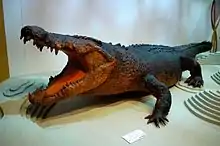Sweetheart (crocodile)
Sweetheart was the name given to a 5.1 m (17 ft) male saltwater crocodile responsible for a series of attacks on boats in Australia between 1974 and 1979. Sweetheart attacked outboard motors, dinghies, and fishing boats, but there is no known case of his attacking humans. In July 1979, Sweetheart was finally caught alive by a team from the Territory Parks and Wildlife Commission, but drowned while being transported when he became tangled with a log.[1] The cause of death was later attributed to drowning, probably due to the administration of the muscle relaxant Flaxedil.[2] The crocodile's mounted body is now on permanent display at the Museum and Art Gallery of the Northern Territory.[3]

The preserved skin and jaws were modelled for an Australian tour and eventually placed as an exhibition at the territory's museum. In interview, Ian Archibald, the taxidermist responsible for preparing the reconstruction, recalled the promotional and political circumstances surrounding the specimen. The newly formed government of the Territory coordinated a herpetology exhibitor, Graheme Gow, and the director of the new museum to prepare a spectacular exhibit of the famous crocodile. The model that supports the skin was built to show the greatest size possible, with the tail rigid and straight, and produced what Archibald considered an unnatural pose. The taxidermist's careful research and preparation has been lauded by others, but Archibald does not take an especial pride in the exhibit.[2]
The story of Sweetheart has been taken with considerable artistic licence by Greg McLean, director of the film Wolf Creek, and made into a film titled Rogue.
References
- Stringer, Col (1986). THE SAGA OF SWEETHEART: The frightening but true story of the Giant Rogue Crocodile who attacked over 15 boats on a N.T. River during the 1970s. Casuarina, N.T.: Adventure Publications. ISBN 0959089632.
- Terzon, Emilia (4 August 2016). "How Darwin's iconic five-metre croc Sweetheart got stuffed". ABC News.
- "Sweetheart, Museum Icon". Museum and Art Gallery of the Northern Territory. Museum and Art Gallery of the Northern Territory. Retrieved 25 June 2016.